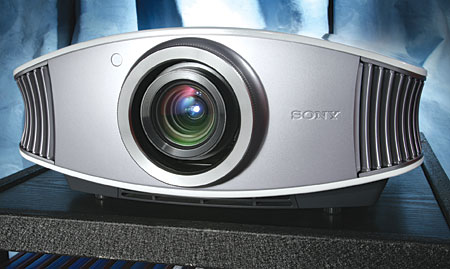1080p Projector Rodeo Sony VPL-VW50
Big Shoes to Fill
Without question, Sony leads this market around by the nose. Their VPL-VW100 came out thousands of dollars below the closest DLP competition. Just a few months later, while the rest of the industry was trying to cope with that shock, Sony released the VPL-VW50 at half the price. If you take everything else out of the equation, Sony is the one to aim for in this market, and many other projectors' design aspects reflect that in some way. Let me put it another way: If Sony put tail fins on their next projector, within six months, every projector in the category would have tail fins.

Sony, of course, knows this. But, while they might not be the first one to market a specific type of product, you can bet they'll come in shortly thereafter with a valiant attempt to take over the category. In many categories, they have succeeded (RPTVs); in others, not so much. (Wait, Sony makes an MP3 player?) The VPL-VW100 was an excellent shot across the bow of every high-end DLP-projector company. The VPL-VW50 attempts to squeeze into that region above all the budget projectors but well below the harsh prices of the high end.
Aesthetically, the VPL-VW50 is related to the VPL-VW100. It's also commendably quiet—the quietest projector here. The menus are colorful and fairly easy to use. There are also innumerable adjustments. The iris alone has four presets, two of which have three further adjustments. One is a sliding manual iris control with 101 steps.
The Sony offers you the ability to adjust the color points and just about everything else. The remote is the same model we've seen with most other Sony projectors. It's backlit but doesn't have direct input buttons. The best way to describe the remote is "innocuous."
 Like the Mitsubishi (and not the JVC), all of the lens functions, like zoom and focus, are motorized. This makes setup a lot easier if you don't have an assistant. Also like the Mitsubishi, and not like the JVC, the Sony has motorized lens shift with a substantial adjustment range.
Like the Mitsubishi (and not the JVC), all of the lens functions, like zoom and focus, are motorized. This makes setup a lot easier if you don't have an assistant. Also like the Mitsubishi, and not like the JVC, the Sony has motorized lens shift with a substantial adjustment range.
The 8,525:1 contrast ratio is impressive, but this is with an auto iris. If you take the iris out of the equation, say by turning it off or manually closing it (both are available in the menu), the contrast ratio is around 1,900:1. So, what you see on the screen is somewhere in between. It looks better than 1,900:1, but it's not quite a real 8,525:1.
The color points out of the box are oversaturated, which is typical of Sony SXRD. What's different here are the Real Color Processing adjustments that allow you to dial in the color points. The result is one of the most accurate Sony products we've seen in years.
The Sony's processing isn't bad, but it's not great. It deinterlaces 1080i correctly and picks up the 3:2 sequence in 1080i material based from film. It picks up 3:2 with 480i fairly quickly with synthetic tests. But, with the real-world Gladiator clip, it was a lot slower, and it occasionally lost the sequence. The VPL-VW50 performed the worst out of these three with the waving-flag test. When I manually switched the DDE mode (the inaccurately named Dynamic Detail Enhancer) to Video, though, the Sony's performance on this test became roughly on par with the JVC's. The Sony was in the middle of this pack with the rotating-bar test. It's also the noisiest (visually speaking) of the three projectors here, but that isn't to say it is overly noisy. Increasing the NR (noise reduction) brings the noise down to a level similar to that of the Mitsubishi, but it softens the image just a bit more.
If you give the VPL-VW50 a 1080p/24 signal, it, like the JVC, changes its refresh rate to 96 Hz and employs a 4:4 pulldown. Also, like the JVC, there is nothing that says this is happening.
One aspect of the Sony's performance that would be hard to detect without direct comparison is a relative softness compared with the other projectors here. It's not a big difference, but, when you A/B/C it to the JVC and the Mitsubishi, it is noticeable. The VPL-VW50 can just barely reproduce the one-pixel-on/one-pixel-off pattern, which would seem to indicate some rolloff in the high frequencies.
When it comes down to it, the Sony VPL-VW50 is a great projector that is outclassed in contrast ratio by the JVC and in processing by the Mitsubishi. But it takes them both on in terms of a sense of balance. It may not be the best in any category, but it will rarely be the worst, either. By far, it has the best enclosure. It's also the most flexible, with a wide variety of lens-shift and iris options that should fit any screen size or room.
One final note: If you end up getting the VPL-VW50, plan on leaving it running outside for about 50 hours. The reek this thing puts off when it's new is breathtaking, which is good because you won't want to breathe near it. After the lamp wears in a bit, it's fine.
Highlights
Sony VPL-VW50 SXRD Projector:
• Nearly silent case
• Extremely flexible




























































